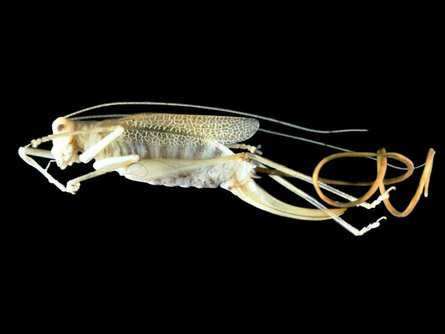Nutrition
What do grasshoppers like to eat?? Grasshoppers are
herbivores and eat grasses, sedges, forbs, and shrubs(Pfadt 2012).
Click this link to see all of the scientific names of the food
that grasshoppers eat!
Deadly Parasites!
Many organisms use the grasshopper as a host. Other insects, nematodes, and mites can live in their bodies or in their eggs. These organisms have the capability of weakening and killing grasshoppers. A wasp like insect of the family Scelionidae parasitize the egg stage while other insects attack the nymphal and adult stages of grasshoppers. Nematodes generally coil up inside the grasshopper and cause death or sterility of the grasshopper. Small red mites are ectoparasites meaning they parasitized externally but do not affect the grasshopper population. The picture above shows a grasshopper parasitized by a hairworm nematode(Glogoza and Weiss 1997).
Eating can be dangerous??
When feeding, grasshoppers have the risk of becoming infected from spores while they are seeking food. It sticks to them and then germinates and penetrates the inside of their cuticle. Once this fungus gets into the grasshoppers bloodstream, it multiplies and eventually begins to grow on their organs. When the grasshopper dies, there are several million spores in their body which end up germinating and creating more sticky spores on the ground when the grasshopper's body disinigrates. This is a naturally occurring disease which is called Entomophaga grylli (Glogoza and Weiss 1997).
A Glance Through the Digestive System
The digestive system consists of three main parts, the foregut, hindgut, and midgut. Food begins in the mouth, to the pharynx and to the esophagus. It begins in the foregut and then gets discharged into the midgut where it leads to the malpighian tubes, which are the chief excretory organs. After, it goes into the hindgut and out the anus. The waste products that grasshoppers expel are uric acid, urea, and amino acids in their dry pellets. Grasshoppers have salivary glands in their mouth to begin the breakdown of food and they also have digestive enzymes in their midgut. These digestive enzymes consist of protease (breakdown of proteins), lipase (breakdown of fats), amylase (breakdown of starch), and invertase (breakdown of sugars)(New World Encyclopedia 2008).
